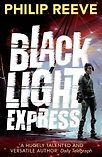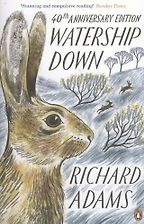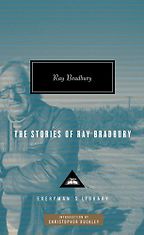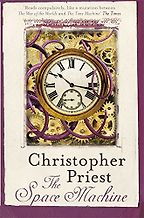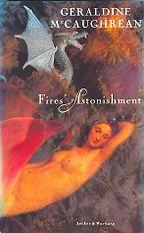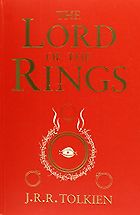We are going to talk about your favorite science fiction and fantasy books. You have chosen books that resonated with you at particular stages in your life – or that were formative in some way.
I tried to choose books that pushed me in particular directions at particular phases of my life. The exception being Watership Down, which is a book I’ve really only come to fairly recently, when I read it to my son. Apart from that, the books I have chosen were ones I came across either as a child or teenager and each had an important influence on me. Consequently they are quite old.
And do you think they’ve influenced your own writing?
In different ways, yes. Sometimes quite specifically and sometimes more loosely.
Where would you like to start?
The Lord of the Rings, I suppose, would be the one to start with because that would be the earliest one. It wasn’t my first great love of a book, but I was quite young when I encountered it. I must’ve been eight or nine, I think, when my mum and dad read that to me – and it was incredibly influential because of the notion of creating a world. I guess I’d already come across that with Narnia. I loved the CS Lewis books when I was seven or eight, and then coming to Tolkien, he just sort of does the same thing in so much more detail and so much more depth and breadth that it was just completely awe-inspiring.
The versions I would have first encountered would have been the hardbacks that my parents borrowed from the library. They had these great, crinkly maps that unfolded from inside the back cover – you could spread them out on the living room carpet and study them for hours. There were all these little places that only get mentioned in passing in the story but there they all are, mapped and visitable.
It was that sense of scale, as well – that sense of this vast world going on, then a vast story being set inside it. It was all very inspiring to a small lad. I read it several times while growing up and each time I got something different from it. I wouldn’t say it’s what inspired me to write because I was already writing by then, but it certainly influenced the sort of things that I do write. It’s how I’ve made my living – I make up worlds. As an adult, there are things about the story that I don’t like so much, but as a creation of an imaginary world, I still think it’s the gold standard.
He created entire languages and mythologies – that’s what gives it authenticity. I interviewed Alan Lee a couple of weeks ago.
Alan Lee is another hero of mine, actually. He’s one of my illustrator heroes from when I was younger.
Alan Lee spoke about Tolkien‘s great connection with the landscape of Dartmoor.
I think that’s another thing for me, another influence that The Lord of the Rings had on me, because I lived in town growing up. I lived in Brighton, in a very ordinary housing estate there, but my parents would take us away on holidays to the Lake District or Wales or Dartmoor and Cornwall and places like that, and I think that The Lord of the Rings gave me a context to see these landscapes in. I was always very drawn to these western upland, granitic landscapes, and yes, I think it’s partly because they provided the scenery for me for when I was reading The Lord of the Rings. Dartmoor is extraordinarily Tolkien-esque. It’s covered in old stone circles and abandoned buildings and things. It’s wonderful. I don’t know if Tolkien knew Devon at all, but the early parts of The Lord of the Rings, the Shire, and the Barrow-downs – are basically Dartmoor. So I’m going to claim it as the great Dartmoor book.
I grew up in rural North Derbyshire, and shortly after reading The Hobbit, I could see dragons sleeping just under the surface of the mountains.
Yes, yes, yes. I remember doing that. Looking at the landscape and imagining a giant or something slumbering under it.
It is quite incredible that reading a book can change your relationship or influence our relationship to landscape.
It’s a two-way street as well, because I think I already had this fascination with the landscape. As a smaller child I didn’t really have a frame to view it through, and then The Lord of the Rings provided that. I think it’s about the English landscape, really. One of the things you notice as you read it, or I notice now as I read it, is that everywhere in it has at least three names. Everywhere they go, it has the name that’s used now, and the name in Old Elvish, and then a dwarf name or something. So it has this deep sense of history in the landscape which is so very important to me.
Which book would you like to talk about next?
Watership Down, which I read as a young teenager. I enjoyed it but it didn’t have a huge impact that The Lord of the Rings did. But when I read it to my son recently I was hugely impressed by it. It’s a fantastic book and it belongs next to Tolkien on the science fiction and fantasy shelves. It’s basically about this parallel civilization existing under our feet. It’s a really strange book, far stranger than people give it credit for.
There are generally two ways of writing about hedgerow animals. One is the Beatrix Potter, Kenneth Grahame way where they have clothes and houses and are like little people, and then the other is the Henry Williamson, Tarka the Otter way where you try to get yourself completely into the mind of a wild animal. Watership Down does both. The rabbits’ behaviour and their social structures are based on reality, but Richard Adams gives them a language and mythology of their own. Their thought processes are not human thought processes, so, for example, when they encounter something like a car or a boat, they’re not capable of understanding it. They have to puzzle it out, and they start to dimly perceive what it might be, but they don’t really get it. I think anybody who’s a science fiction writer should read Watership Down because it’s about alien intelligence. It’s about intelligent creatures who are not human beings and don’t think like us, and it’s got this bizarre structure. It has the scale of The Lord of the Rings and again, like Tolkien, you sense that it’s actually about the 20th century. It’s about the great disasters of the 20th century, and just as Tolkien is working through his experiences of the First World War, with the Mordor scenes and the Dead Marshes in The Lord of the Rings, I wonder if Richard Adams is doing something similar with his memories of World War Two. I don’t know exactly what his war time experiences were, but Hazel is like a young officer trying to hold together this group of disparate characters, and of course General Woundwort’s warren is a sort of rabbit version of the totalitarian states of the 20th century. So it’s real life shown through a weird, distorting mirror.
Another thing that I like about it is that I don’t think Richard Adams was a good writer. If you read some of his other books, they’re very heavy going, and not many people do read them, for that reason. They’re kind of pompous and laborious. He’s really not a good writer but he created a great book, a genuinely great book. So that’s very hopeful for a writer. Even somebody who’s basically a plodder can be struck by genius.
I think it went out of favour a little bit. Partly because the film is so terrifying.
Yes, everybody talks about it as if it’s this terribly frightening and depressing book, There are terrible things that happen, but they’re in the context of the story. It’s basically quite an uplifting story and I think what happened was probably that in the late 70’s a lot of kids were taken to see the movie version by parents who were thinking that it was going to be a fluffy bunny movie, and it turned out to be quite frightening for them. I think that’s done it a terrible disservice. People think of the film rather than the book, or of their childhood response to the film, and it’s coloured their memories of the book. I was a teenager by the time the film came out, so I did see it, but it made no particular impression on me except I think I went home and then read the book.
I was traumatised by the film and it took me years to read the book. When I did I loved it and still do.
I hope this interview inspires a few more people to read it! We should go to Ray Bradbury next. Fahrenheit 451 is the one that most people seem to know, but it’s actually very atypical of most of his work . I’ve chosen his collected short stories for this interview.
As a teenager I was getting all my books from the library. I was hoovering up anthologies of science fiction stories, most of which came from 1950’s and ’60s American magazines. Ray Bradbury was one of the writers who kept popping out at me from these anthologies, and eventually, I bought myself a big two-volume edition of his collected stories.
He was the first writer I read where I became aware that I wasn’t just reading for the story. I was reading for the way he used language and this very poetic style that he has. Now when I look at it I think it’s a little bit too poetic in parts. It’s a little bit purple in places, but at the time, when I was 13 or 14, it was astonishing to me, and it opened a door for me. I thought, “Oh, okay. If I want to write, it’s not just about the story. It’s about the actual choice of words you make and how you describe things.”
He’s very good at the short story. I’m surprised, looking back at them, how many of them are more mild horror than science fiction or fantasy because I’m not a horror fan at all and never have been. I don’t think I cared, really, because I just liked his vision so much at the time. There’s a fantastic one called The Foghorn where a lonely lighthouse on a fog-bound coast starts sounding its foghorn and a prehistoric monster, which has been sleeping at the bottom of the sea for centuries, wakes up hearing this and thinks that it’s another prehistoric monster calling to it. It’s so lonely, this poor creature. So it’s basically a 1950s monster movie, and I think it actually did end up getting turned into a rubbish, “brontosaurus-rampaging-through-New York” film. In the story your sympathy is with the monster completely and it’s just this sad story about the monster hearing the foghorn and thinking that there’s another like it somewhere and then learning that it’s all alone after all. People say, sometimes with justification, that science fiction isn’t interested in emotions and feelings and characters and things, but Ray Bradbury is. And he is brilliant for that reason.
I find quite a lot of the sci-fi I read as a teenager is now really dated. Most of the stuff I was reading was from before computers were invented and so people on their super advanced 25th century spaceships are still using valve radios and stuff.
But with Ray Bradbury, it doesn’t actually matter. It’s notional – the rocket ships and things. He’s not trying to be plausible. He’s not trying to predict the future in any way. He’s just spinning stories, and the stories are all about the people and the spindly, silver rocket ships are just a way of getting them to Venus or Mars or somewhere so that a story can occur.
So there is no real interest in science except this great sense of wonder that does then send you off to read about Mars for real. There’s an opening passage here which sums up what Ray Bradbury is about for me. It is from a story called Mars is Heaven and it goes, “The ship came down from space. It came from the stars and the black velocities, and the shining movements, and the silent gulfs of space.” That to me, is so spine-tingly, and that is very much what drew me in as a teen. I read Ray Bradbury and it made me go and write lots of short stories and most of them, well, all of them probably, were rubbish, but at least I was writing.
There is often an urgency to them which appeals to young adult readers. It’s a great form, the short story.
Yes, it is, but eventually, I found that what appeals to me, much more, was the Tolkien scale. I didn’t really want to write little perfectly crafted short stories. I wanted to spread my imagination across vast landscapes. So as an adult I’ve never really written short stories seriously, but I do like reading them, and I admire well-written ones.
Another thing that I got from Bradbury and from a lot of writers of his generation was that they were very happy to name-check the great writers they’d been influenced by. So, from Bradbury, I was sent on, to read people like Steinbeck and Hemingway, whom I might never have come across otherwise.
Those pulp magazines probably would have been read by lots of not particularly well-educated teenagers, in that particular era, and it presented them with a little gateway to higher culture, and I rather like that.
Where next on our journey?
I thought that leads neatly to Christopher Priest, The Space Machine. I was trying to think of science fiction novels that had inspired me, and it was tricky to pick any one because I read sci-fi very intensely for about two or three years in my early teens and it was almost all short stories. It wasn’t like there was one book that obsessed me. It was just I liked the genre and I liked the ideas it threw at you. A lot of the stories were quite bad, but it didn’t matter because a) a bad book can still have a good idea in it; and b) I have enormous affection and admiration for all the terrible writers I read growing up, because they inspired me – I sort of thought, “Well, I may not be very good, but I’m not as bad as he is.”
There were some good writers too – one of the most out-standing being Christopher Priest. I think he was one of the English new wave of the 1970’s science fiction writers. I didn’t really get his books at first. To be honest, I didn’t really understand them. I could see they were beautifully written and kind of fascinating but I didn’t really know what was going on. Then I discovered The Space Machine.
The Space Machine is an HG Wells pastiche. Priest sat down in 1976 and wrote a scientific romance of the sort that HG Wells would have written in about 1896. He smashes together the plots of The Time Machine and The War of the Worlds and he does it very wittily, and very effectively. His young hero and heroine encounter the inventor of the time machine, they take a trip on it, and they discover that as well as moving them in time, it moves them in space. They arrive on Mars where the Martians are preparing to launch their invasion towards Earth. They return to England by stowing away on one of the Martian cylinders and landing at the beginning of The War of the Worlds. It’s a while since I read it but it does end up with them flying around on a bedstead dropping bombs down the turrets of Martian war machines. It’s tremendous fun. It’s hugely page turning.
Get the weekly Five Books newsletter
It made me realise, as a teenager, that science fiction didn’t have to be about the future. All these previous things, all the glories of the scientific romance were still open to me. I could sit down and write one of those and quite often did as a young man. I guess eventually that evolved into Mortal Engines. It is set in the future, in a rather retro society – in that it has Victorian and Dickensian influences. It was The Space Machine that set me going down that road and I’m assuming it’s still in print.
Yes. Very much in print. I’m so pleased you have introduced me to his writing.
Of all the sci-fi books I remember reading I think that’s most fun. I think I read it in one sitting. Christopher Priest is very good with the Victorian period and sensibility. The Prestige is my favourite of his other books. It’s about two rival Victorian stage illusionists, and they’re trying to outdo each other in a trick where they disappear in one part of a theatre and reappear in another. One of them has a secret identical twin, so he speeds ahead, but the other one, in frustration, heads off to America and goes to visit Tesla, the great inventor and gets him to invent a matter transporter which will literally transport him from one bit of the theatre to another – but there’s a terrible catch. Though this science fiction element creeps into it, it feels like a pitch perfect recreation of the time.
Now, we’re heading to one of my favourite writers, Geraldine McCaughrean.
I used to work in a bookshop back in the ’90s down in Brighton and I was looking around one night for something to read and came across this, Fires’ Astonishment by Geraldine McCaughrean.
I didn’t realise at the time, but she’s known as a children’s novelist and she’s probably, for my money, our best children’s novelist. She’s absolutely superb, but I’d never heard of her till then. I’m not sure if many of her children’s books had even been published back then. I think this is probably the beginning of her career, published in 1990. It’s an adult novel, and it basically spins off from a mediaeval poem, about a duke’s son whose wicked stepmother transforms him into a dragon. It uses this as a basis for this little world, this quite small community, where various different characters interact. You have the wicked stepmother and the duke, and you have the son’s fiancée, who isn’t going to be able to get to marry him now because he’s vanished mysteriously, at the same time this dragon appears. So she ends up marrying a much older man, and you assume this is going to go badly wrong. But it doesn’t. It really works and becomes this rather beautiful romance. Geraldine McCaughrean keeps on doing this. She’s constantly surprising you. She has this way of just twisting your expectations around. When you’re a writer, and you spend a lot of time reading, a lot of time thinking about stories, you tend to be able to spot what’s going to happen next quite often, but with Geraldine McCaughrean, I very often can’t. She very often surprises me and she does in this book.
She also had the best dragon ever. It’s my favourite dragon in all of literature. It’s the most physical dragon. She describes it incredibly well – the smell of it, the itchiness of the scales – it just feels like a real, living thing. There’s nothing very magical about it. It’s just this big, slightly dangerous animal, and being stuck inside it, the poor old son and heir is gradually becoming less human and more dragonish. He meets up with a failed monk who befriends him rather reluctantly and they travel on together.
Of course, everyone is terrified of the beast. So hunts are organised to kill it. So, again, I suspect, as with Ray Bradbury and the prehistoric monster in The Foghorn, you sympathise with the monster. It’s just the most wonderful story told with an incredible use of language. Absolutely extraordinary. Her way with metaphors – there’s no one who writes like she does. I won’t pull an example out, but she has this way of linking one metaphor into the next, so you get these little chains leading you through a passage of writing. I read this book without any expectations at all. I literally picked it at random off the shelf thinking, “Oh, it’s about the middle ages. That sounds quite interesting,” and I was astounded by it. At a second hand shop somewhere I found another book of hers called Vainglory, which is another medieval novel, absolutely mind-blowing.
It was around the time I was moving from being a bookseller to being an illustrator, and these were the books that made me want to write. These are the ones that really, finally made me think, “Okay. I have got to write novels. This is what I have to do.” So all the other books that we mentioned were fuel, but Geraldine McCaughrean was the spark that lit it. That was what got me really writing seriously.
I started writing Mortal Engines which was going to be an adult book but I couldn’t find a publisher or an agent who would even read it, let alone publish it. Nobody wanted to look at it, so eventually, I took it to a children’s publisher and it became a children’s book. Around then I discovered that Geraldine was now a children’s writer and I actually got to meet her in the course of my career, which has been wonderful.
There is no writer I admire more. Every Geraldine McCaughrean book is worth reading. They all have this beautiful, rich language and this sort of wayward storytelling. Fires’ Astonishment is still my favourite.
She’s got this streak of cruelty in her, and being a kind and responsible writer, she reins it in when she’s writing for children. When she’s writing for adults, she’s very … not bleak exactly, but very unsentimental. Bad things happen. Vainglory is astonishing, the number of sympathetic characters who you think are the main characters of the book – who then just get killed off unexpectedly. She keeps doing it!
I’ve seldom met anyone with an imagination like that. It’s so rich and there’s so much in there. Now that I’ve read dozens of her books, I can see that there are recurring themes but really, they’re all very different.
Everything you read is fuel to the imagination, I guess, but there are particular things that you adopt, or they really influence you and I think you can see the influence in all of these books on what I write. I try to write as well as Geraldine. I never will, because very few people can. I try to make the words interesting and make it to flow with that sort of grace and I try to aim for Christopher Priest’s lightness of touch and just that sense of lots of ideas being thrown at you.
I like books that fling ideas at you, that you can grab or let fall. The air is full of flocks of ideas. And the big Tolkien world building thing – all this went into Mortal Engines and its sequels.
Mortal Engines was 16 years ago now. I wrote sequels and prequels set in the same world, and when that all came to an end I thought I should do something different. So I started writing books for younger children with the illustrator Sarah McIntyre, which has been fantastic. It was completely rejuvenating for me, and good to do something completely different and get somebody else’s ideas into it as well. There was a great sense of reinvigorating my work and one of the results was that it made me want to write another huge world – and that became Railhead and its sequel Black Light Express I’m busy on the third Railhead book at the moment. Black Light Express is in paperback on the third of August.
So that’s what I’m busy with at the moment. That’s the world I’m living in for the time being.
Interview by Zoe Greaves
September 14, 2017. Updated: March 11, 2024
Five Books aims to keep its book recommendations and interviews up to date. If you are the interviewee and would like to update your choice of books (or even just what you say about them) please email us at [email protected]
Five Books interviews are expensive to produce. If you've enjoyed this interview, please support us by donating a small amount.

